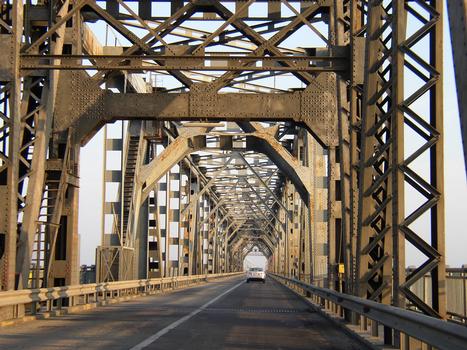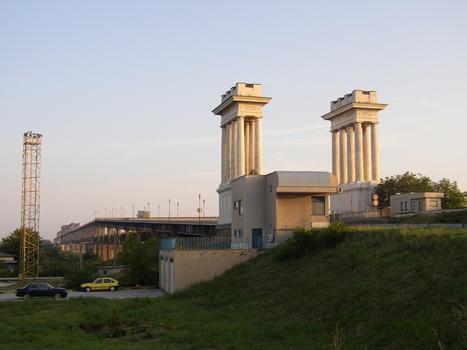General Information
| Other name(s): | Friendship Bridge; Giurgio-Ruse Bridge |
|---|---|
| Beginning of works: | 1952 |
| Completion: | 20 June 1954 |
| Status: | in use |
Project Type
| Structure: |
Through truss bridge Vertical lift bridge Truss bridge with suspended deck |
|---|---|
| Support conditions: |
for registered users |
| Function / usage: |
upper deck: Road bridge lower deck: Railroad (railway) bridge |
| Material: |
Steel bridge |
| Plan view: |
Structurae Plus/Pro - Subscribe Now! |
Location
| Location: |
Giurgiu, Giurgiu, Romania Ruse, Ruse, Bulgaria |
|---|---|
| Crosses: |
|
| Coordinates: | 43° 53' 13.22" N 26° 0' 28.28" E |
Technical Information
Dimensions
| total length | 1 058.00 m | |
| span lengths of main bridge | 2 x 120.00 m - 85.00 m - 2 × 120.00 m | |
| length of movable section | 85.00 m |
Materials
| truss |
steel
|
|---|
Excerpt from Wikipedia
The Danube Bridge (formerly known as the Friendship Bridge; Bulgarian: Мост на дружбата, Most na druzhbata or, more commonly, Дунав Mост, Dunav most; Romanian:Podul Prieteniei or Podul de la Giurgiu) is a steel truss bridge over the Danube River connecting the Bulgarian bank to the south with the Romanian bank to the north and the cities of Ruse and Giurgiu respectively. It is one of only two bridges connecting Romania and Bulgaria, the other one being the New Europe Bridge between the cities of Vidin and Calafat. The Danube bridge can be reached by using public transport - bus lines 4,11,12 and 28.
History
Opened on 20 June 1954 and designed by Soviet engineers V. Andreev and N. Rudomazin, the bridge is 2,223.52 m (7,295.0 ft) long and was, at the time, the only bridge over the Danube shared by Bulgaria and Romania, with other traffic being served by ferries and land routes. Decorations were designed by Bulgarian architect Georgi Ovcharov. The bridge has two decks; a two lane motorway and a railway. Sidewalks for pedestrians are also included. The central part of the bridge (85 m) is mobile and can be lifted for oversized boats passage. The maintenance of the mobile part is Romania's responsibility and is periodically checked. The bridge was constructed in two and a half years with the aid of the Soviet Union.
The Soviets named it the "Friendship Bridge", but, since the fall of the communist regimes in both countries, the bridge got the more functional name of "Danube Bridge".
Border control stations are present on the bridge, due to ist serving as a border crossing between the two countries. Since January 2007 there is no more customs control and the passport/identity card control is done "on one desk" either by the Bulgarian or the Romanian border police, being an "internal border" within the European Union. Border control will be completely removed when Bulgaria and Romania join the Schengen Agreement.
On 3 September 2011 the Bulgarian part of the bridge was opened, after two months of rehabilitation.
There are a pair of rectangular towers supported by pillars on both ends.
Text imported from Wikipedia article "Danube Bridge" and modified on 23 July 2019 under the CC-BY-SA 3.0 license.
Participants
- P. Andreev (designer)
Relevant Web Sites
Relevant Publications
- (2009): The history of the Romanian Danube bridges. Presented at: Third International Congress on Construction History, Brandenburg University of Technology Cottbus, Germany , 20th-24th May 2009.
- (1998): The new Romanian Danube Bridges in Fetesti-Cernavoda after 10 years of operation. Presented at: 3. Internationale Donaubrückenkonferenz, 3rd International Conference on Bridges across the Danube, 29-30/10/1998, Regensburg, Germany, pp. 25-36.
- About this
data sheet - Structure-ID
20003718 - Published on:
20/06/2002 - Last updated on:
12/06/2021






